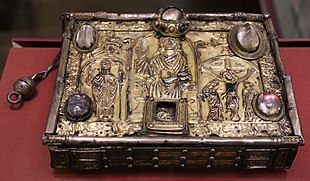
Beltane or Bealtaine is the Gaelic May Day festival, marking the beginning of summer. It is traditionally held on 1st May, or about midway between the spring equinox and summer solstice. Historically, it was widely observed in Ireland, Scotland, and the Isle of Man. In Irish the name for the festival day is Lá Bealtaine while the month of May is Mí na Bealtaine, in Scottish Gaelic Latha Bealltainn, and in Manx Gaelic Laa Boaltinn/Boaldyn. Beltane is one of the four main Celtic seasonal festivals—along with Samhain, Imbolc, and Lughnasadh—and is similar to the Welsh Calan Mai.

Imbolc or Imbolg, also called Saint Brigid's Day, is a Gaelic traditional festival. It marks the beginning of spring, and for Christians, it is the feast day of Saint Brigid, Ireland's patroness saint. It is held on 1 February, which is about halfway between the winter solstice and the spring equinox. Historically, its traditions were widely observed throughout Ireland, Scotland and the Isle of Man. Imbolc is one of the four Gaelic seasonal festivals, along with: Beltane, Lughnasadh and Samhain.

Samhain, Sauin or Oíche Shamhna is a Gaelic festival on 1 November marking the end of the harvest season and beginning of winter or "darker half" of the year. It is also the Irish language name for November. Celebrations begin on the evening of 31 October, since the Celtic day began and ended at sunset. This is about halfway between the autumnal equinox and winter solstice. It is one of the four Gaelic seasonal festivals along with Imbolc, Bealtaine, and Lughnasa. Historically it was widely observed throughout Ireland, Scotland, and the Isle of Man. A similar festival is held by the Brittonic Celtic people, called Calan Gaeaf in Wales.

Scottish Gaelic, also known as Scots Gaelic or simply Gaelic, is a Goidelic language native to the Gaels of Scotland. As a Goidelic language, Scottish Gaelic, as well as both Irish and Manx, developed out of Old Irish. It became a distinct spoken language sometime in the 13th century in the Middle Irish period, although a common literary language was shared by the Gaels of both Ireland and Scotland until well into the 17th century. Most of modern Scotland was once Gaelic-speaking, as evidenced especially by Gaelic-language place names.
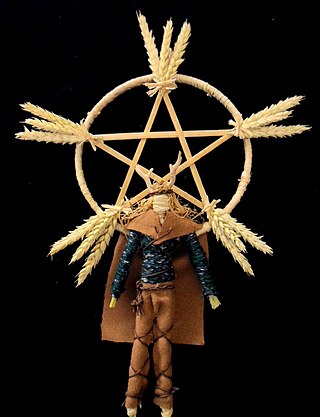
Lughnasadh, Lughnasa or Lúnasa is a Gaelic festival marking the beginning of the harvest season, and an official holiday in Ireland. Historically, it was widely observed throughout Ireland, Scotland and the Isle of Man. Traditionally it is held on 1 August, or about halfway between the summer solstice and autumn equinox. In recent centuries some of the celebrations have shifted to the Sunday nearest this date. Lughnasadh is one of the four Gaelic seasonal festivals, along with Samhain, Imbolc and Beltane. It corresponds to the Welsh Gŵyl Awst and the English Lammas.

Bon or Bön, also known as Yungdrung Bon, is the indigenous Tibetan religion which shares many similarities and influences with Tibetan Buddhism. It initially developed in the tenth and eleventh centuries but retains elements from earlier Tibetan religious traditions. Bon is a significant minority religion in Tibet, especially in the east, as well as in the surrounding Himalayan regions.

The Cathach of St. Columba, known as the Cathach, is a late 6th century Insular psalter. It is the oldest surviving manuscript in Ireland, and the second oldest Latin psalter in the world.

Mount Kailash is a mountain in Ngari Prefecture, Tibet Autonomous Region of China. It lies in the Kailash Range of the Transhimalaya, in the western part of the Tibetan Plateau. Mount Kailash is less than 100 km north of the western trijunction of the borders of China, India, and Nepal.

Widdershins is a term meaning to go counter-clockwise, anti-clockwise, or lefthandwise, or to walk around an object by always keeping it on the left. Literally, it means to take a course opposite the apparent motion of the sun viewed from the Northern Hemisphere. The earliest recorded use of the word, as cited by the Oxford English Dictionary, is in a 1513 translation of the Aeneid, where it is found in the phrase "Abaisit I wolx, and widdersyns start my hair." In this sense, "widdershins start my hair" means "my hair stood on end".
Hugh Roe O'Donnell, also known as Red Hugh O'Donnell, was a sixteenth-century Irish clan chief, Lord of Tyrconnell, and senior leader during the rising of the Irish clans against English rule in Ireland known as the Nine Years War (1593-1602). While Hiram Morgan has contemptuously dubbed Hugh Roe O'Donnell, "a counter-reformation Irish dynast living in the world of Machiavelli's Prince rather than The Cattle-Raid of Cooley", Morgan also concedes that primary sources other than the Elizabethan era English officials who wrote the Calendar of State Papers depict Hugh Roe as a man who genuinely believed in and lived by the traditional code of conduct demanded of an Irish clan chief. For this reason, Hugh Roe remains an iconic figure in the history of Irish nationalism and has recently drawn comparisons in the Spanish news media to both El Cid and William Wallace.
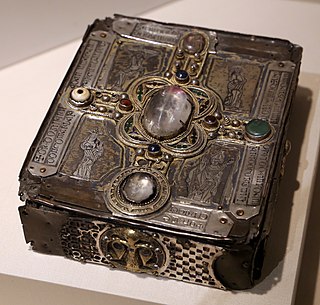
A cumdach or book shrine is an elaborate ornamented metal reliquary box or case used to hold Early Medieval Irish manuscripts or relics. They are typically later than the book they contain, often by several centuries. In most surviving examples the book comes from the peak age of Irish monasticism before 800, and the extant cumdachs date from after 1000, although it is clear the form dates from considerably earlier. The majority are of Irish origin, with most surviving examples held by the National Museum of Ireland (NMI).

The O'Donnell dynasty were the dominant Irish clan of the kingdom of Tyrconnell in Ulster in the north of medieval and early modern Ireland.
A pattern in Irish Roman Catholicism refers to the devotions that take place within a parish on the feast day of the patron saint of the parish, on that date, called a Pattern day, or the nearest Sunday, called Pattern Sunday. In the case of a local folk saint from Celtic Christianity, there may be archaeological remains traditionally associated with the saint, such as holy wells reputed to have healing powers. Often the parish priest will say Mass or lead prayers at such a site, sometimes processing between several locations. In some parishes, Pattern Sunday coincides with Cemetery Sunday, an annual ancestor veneration observance held in cemeteries which typically includes the cleaning and decoration of family graves as well as religious rituals.
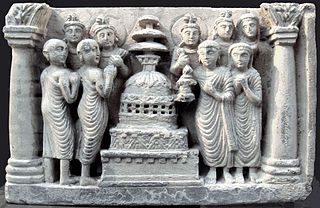
Circumambulation is the act of moving around a sacred object or idol.

Killin is a village in Perthshire in the central Highlands of Scotland. Situated at the western head of Loch Tay, it is administered by the Stirling Council area. Killin is a historic conservation village and sits within the Loch Lomond and The Trossachs National Park. It is the central settlement of the historic region of Breadalbane.
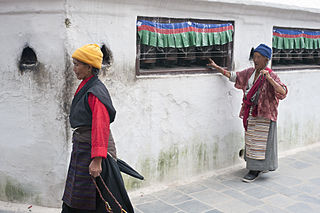
Kora is a transliteration of a Tibetan word that means "circumambulation" or "revolution". Kora is both a type of pilgrimage and a type of meditative practice in the Tibetan Buddhist or Bon traditions. A Kora is performed by the practitioner making a circumambulation around a sacred site or object, typically as a constituent part of a pilgrimage, ceremony, celebration or ritual. In broader terms, it is a term that is often used to refer to the entire pilgrimage experience in the Tibetan regions.

Termon is a village in the north of County Donegal, Ireland.
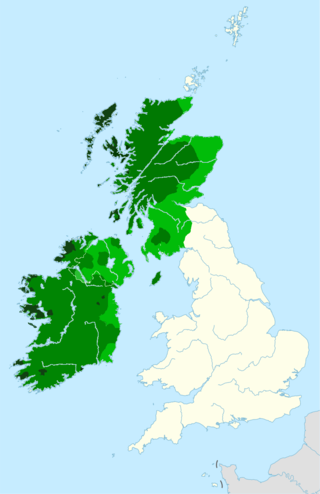
The Gaels are an ethnolinguistic group native to Ireland, Scotland and the Isle of Man. They are associated with the Gaelic languages: a branch of the Celtic languages comprising Irish, Manx and Scottish Gaelic.

Two-dimensional rotation can occur in two possible directions or senses of rotation. Clockwise motion proceeds in the same direction as a clock's hands relative to the observer: from the top to the right, then down and then to the left, and back up to the top. The opposite sense of rotation or revolution is anticlockwise (ACW) or counterclockwise (CCW). Three-dimensional rotation can have similarly defined senses when considering the corresponding angular velocity vector.
The battle of Cúl Dreimhne took place in the 6th century in the túath of Cairbre Drom Cliabh in northwest Ireland. The exact date for the battle varies from 555 AD to 561 AD. 560 AD is regarded as the most likely by modern scholars. The battle is notable for being possibly one of the earliest conflicts over copyright in the world.
